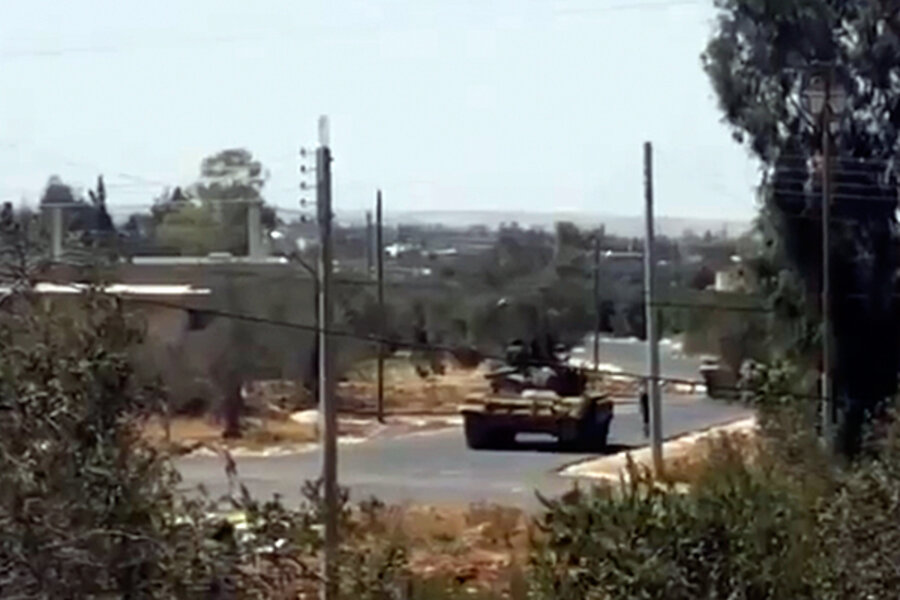Military analysts say Syrian Army is far from point of collapse
Loading...
| Antakya, Turkey
Though degraded by a war of attrition against increasingly capable guerrilla militias, the Syrian military remains a cohesive force capable of continuing its operations for the foreseeable future, according to independent military analysts.
The assessment that the Syrian military remains a potent force contradicts months of suggestions by Obama administration officials that defections and the pace of the increasingly violent conflict is overstretching the military, a theme that’s been voiced repeatedly for months in official State Department briefings.
“We think that the army is increasingly overstretched. We think that the economy is under increasing strain. And we think the rebels are getting stronger,” State Department spokesman Patrick Ventrell said Aug. 9 in one typical comment.
Yet despite a bombing in July that killed four of President Bashar Assad’s closest advisers – including his minister of defense – Syrian military strategy has changed little from six months ago: using the highly mechanized army – built to fight the Israeli army – to surround rebel-held areas and pound them with artillery and airstrikes before making incursions with infantry and paramilitary forces.
“They’re still capable of handling the threats that they’re dealing with, and they’ve been reaching deeper and deeper and deeper into their armory,” said Joseph Holliday, a researcher at the Institute for the Study of War in Washington who specializes in the Syrian conflict.
That’s not to say that the rebels haven’t made the conflict costly for the military. Since the conflict began, the military has been forced to call up reserves and it continues to use paramilitary forces to supplement its infantry.
“They’re taking somewhere around 40 (killed in action) a day. If you extrapolate from that, wounded would be about four times that number. So you can see there’s a steady toll just from combat on the army,” said Jeff White, a senior defense fellow at the Washington Institute for Near East Policy.
While there continue to be individual defections from the military, mass defections generally haven’t occurred, something Holliday credits in part to a government strategy of teaming units made up of conscripts with more professional, better trained troops.
“They are pairing their elite, reliable units with their less reliable units to prevent defections,” Holliday said.
White thinks the overall trend is downward for the army and that the rebels eventually will prevail. He thinks the fact that the rebels continue to contest areas in Aleppo, Syria’s largest city, and in Damascus, the capital, show the military’s weaknesses.
“The army’s going to become less and less capable of conducting operations successfully, and I think the best example of that now is Aleppo,” he said. “The city is critical to the regime by all accounts, and it is disputed territory. For the regime, I think that is defeat. It’s not decisive defeat, but the regime’s inability to reclaim the city is a defeat.”
Holliday is more skeptical. “The rebels are trying to harass supply lines, but the corollary to that is that the regime is making sure it has everything it needs in place. It’s not going to lose a fight in Aleppo,” Holliday said.
The mixing of army units that Holliday described has made it difficult to track which military units are fighting where, though Holliday said it was clear that Syria’s 4th Armored Division and Republican Guard were undertaking most of the fighting near Damascus. The 4th Armored Division is led by Assad’s brother, Maher Assad.
The rebels have managed to destroy significant amounts of the army’s equipment, becoming particularly adept at attacking armored vehicles with rocket-propelled grenades and roadside bombs.
“At the beginning we were seeing T-72s,” White said, referring to the most advanced tanks, bought from Russia, that the Syrian army possesses. “Now we’re seeing some T-54s and T-55s.”
T-54s and T-55s are Cold War-era tanks that first went into production at the end of World War II.
But the army hasn’t yet deployed some of its heaviest weaponry. Despite punishing artillery and rocket strikes on rebel-held areas, a number of rocket and artillery systems haven’t yet been used.
“To me, that’s the most important advantage the Syrian military has over the rebels,” White said.
He predicted that the rebels eventually will acquire anti-aircraft weapons or learn to use the weapons they have to shoot down jets and helicopters, which the Assad military has begun to use more frequently. The use of jets to bomb rebel positions is among the developments that led the death toll to surge in August to 5,384, more than triple the number of dead recorded in May and the highest monthly total yet of the 18-month conflict.
But that won’t erode the regime’s advantage in artillery, White said. “The one thing they will find it very difficult to deal with is the artillery,” he said of the rebels.
White said that even if the military were to be broken, it probably wouldn’t end the violence. He suggested that some commanders would use the mayhem to set up regions that they’d control. “It isn’t going to be just one outcome for the army,” he said.
Holliday pointed to the shabiha, a pro-government militia whose membership is drawn largely from Syria’s Allawite religious minority, to which Assad and much of the country’s elite belong, as one likely outcome for a dissolved army. The militia has been used as infantry across the country, and human rights groups and the rebels accuse it of carrying out some of the worst atrocities in the conflict to date.
“The shabiha are a big deal, not only because they’re being used as infantry, but it’s also a nightmare scenario for what the army could become,” Holliday said.
Enders is a McClatchy special correspondent. Email: denders@mcclatchydc.com Twitter: @davidjenders





